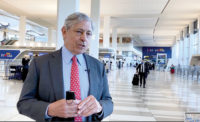Geoffrey Neumayr
San Francisco
ENR 9/5-12/16 p. 11
SFO executive leads airport capital program setting high bar for contractual success.
David Burrus, project executive at Turner Construction, loves building airports. He has seen the widespread efforts to make the project-delivery process more efficient, from construction manager-at-risk to indefinite delivery, indefinite quantity. But among all the U.S. airports making these efforts, he points to one that stands out: the San Francisco International Airport—and its chief development officer, Geoffrey Neumayr.
“Geoff is very progressive in every stretch,” says Burrus. “He is always out there trying to make it better.”
SFO’s progressive design-build approach has resulted in no claims despite millions of dollars in construction over the past several years, including a nearly $400-million renovation of Terminal 2 and a $142-million air traffic control tower that is the first of its kind to employ a performance-based seismic design with vertical post-tensioning. It is also the tallest vertically post-tensioned structure in California.
The Hensel Phelps-Fentress team saw scope increases and a 70% cost hike from the airport’s initial estimate, but the JV was able to deliver the project on schedule and under a progressive maximum-price contract because it could anticipate and accommodate potential changes.
“We don’t deal in that world of disputes,” says Neumayr. “They have no reason to occur because there’s a precursor to disputes. An issue is a precursor to a problem that hasn’t happened yet but might happen. We get those out on the table in a collaborative environment, where now people are not afraid to bring it up.”
Neumayr cautions against thinking that any delivery method is a silver bullet. “It’s nothing new. We know they’re all out there—lean construction, design-build, et cetera. But you get people who want to pick and choose or have a single- item agenda. If you don’t address the environment of collaboration and add structure, you end up with chaos.”
The basic premise is, he says, treating all project team members as co-creators and professionals, not commodities. “One of the things that happens is that, as an airport and owner, you have to be vulnerable. Listen to new ideas. Some might not work, but most will.” As the airport continues with a five-year, $6-billion capital program, Neumayr says, “Any consultants we hire realize that we won’t tolerate treating people poorly.”
Neumayr credits his predecessor, John Martin, with creating the legacy he is now carrying forward. Contractors are not the ones he had to convince, he adds, saying, “We’ve had 40 years of lump-sum bidding in this country in public agencies. There’s been a tremendous amount of litigation. That’s tough to get over. We begin to enforce absolutes. Skeptics say, if you break from tradition and change the metrics and management and assign risk, something will go wrong and you won’t be to blame. We said we will not document how to take care of ourselves in a claim but, rather, have no claims.”





Post a comment to this article
Report Abusive Comment